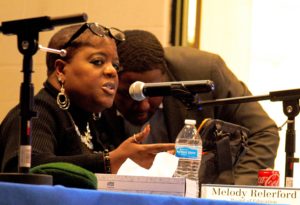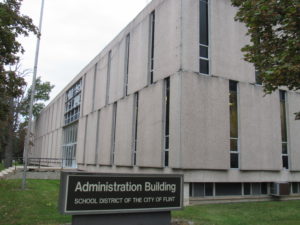By Harold C. Ford
At a special meeting Oct. 5, the Flint Board of Education (FBOE) voted to close two elementary schools in the next two years.
The FBOE voted 6-1 to close Pierce Elementary to students on Flint’s near east side at 1101 W. Vernon Dr. in the 2024-25 school year. Votes for closing Pierce came from: Michael Clack, president; Joyce Ellis-McNeal, vice president; Claudia Perkins, secretary; Laura MacIntyre, assistant secretary/treasurer; Dylan Luna, treasurer; and Terae King, trustee.
The only vote against the motion to close Pierce came from Melody Relerford, trustee. “Pierce is stable … the leadership is impeccable,” she said. “Their (test) scores are impeccable.” Relerford argued that the Neithercut or Eisenhower buildings should be among the first to be closed.

FBOE Trustee Melody Relerford. (Photo by Tom Travis)
The FBOE voted 4-3 to close Neithercut Elementary on Flint’s southwest side at 1010 Crestbrook Ln. in the 2025-26 school year. Voting to close Neithercut were: Clack, Luna, King, and Relerford. Voting against were Perkins, McNeal, and MacIntyre.
“Having all these buildings is not working for us,” Kevelin Jones, Flint schools superintendent, said at the meeting.
Four buildings to close in three years
Earlier in the FBOE’s discussion about building closures, the board voted 5-2 to close four buildings in three years: one building in 2024-25, two in 2025-26, and one in 2026-27. That motion passed by a 5-2 margin with Relerford and MacIntyre casting the “no” votes.
“We are finally moving forward,” Dylan Luna, Flint school board treasurer, asserted.
However, the momentum on building closures came to a halt after the Pierce and Neithercut votes.
Subsequent motions to close Eisenhower Elementary, 1235 Pershing St. and the district’s administration building at the corner of Crapo and Kearsley Streets failed on votes of 3-4 and 2-5 respectively.
Votes to close Eisenhower came from Luna, King, and Relerford. “No” votes were cast by Clack, McNeal, Perkins, and MacIntyre.
Votes to close the administration building were made by Luna and King; Clack, McNeal, Perkins, and MacIntyre voted “no.”
Supt. Jones admitted that the district’s administration building is “under capacity.” Relerford explained her “no vote” saying, “The administration building is the Pentagon of the school district.”
Luna and King have led the charge to “rightsize” the district in terms of its building lineup ever since they occupied their FBOE seats in January 2023. “This has been kicked along by this board too many years,” Luna said.
Recently, FBOE members have spoken of building closures as a “repurposing” of buildings. “Repurposing buildings,” MacIntyre said, “that’s great.”
Nonetheless, the most recent offer to “repurpose” a building – an offer by Liberty Way Holdings LLC to purchase Zimmerman for $250,000 – was voted down by the FBOE at its Apr. 19 meeting. MacIntyre slammed the bid as “discouraging and disheartening … disingenuous.”
45 buildings closed in 41 years, none in past six years
The last time Flint Community Schools (FCS) closed a school building was Flint School of Choice in 2017, six years ago. As the chart below shows, from 1976 to 2017, FCS leadership closed, repurposed, abandoned, or demolished at least 45 school buildings* in 41 years mostly in response to Flint’s overall population loss and the subsequent decline of FCS student enrollment.
- Before 2000; seven buildings closed: Oak (1976), Flint Academy/formerly Flint Northern (1988), Jefferson (1988), Emerson (1988), Lewis (1991), Dewey (1991), Lincoln (1999).
- 2000-2009; 17 buildings: Stevenson (early 2000s), Cook (2002), Lowell (2003), Sobey (2003), Lawndale (2003), Manley (2003), Johnson (2006), King (2006), Longfellow (2006), Whittier (2008), Gundry (2008), Merrill (2009), Stewart (2009), Anderson (2009, sold 2015), Central (2009), Civic Park (2009), Garfield (2009).
- 2010-2019; 21 buildings: Wilkins (2010), Homedale (2010), Williams (2010), Coolidge (2011), Kennedy (2011), Martin (2011), Bunche (2012), Cody (2012), McKinley (2012), Summerfield (2012), Dort (2013), Washington (2013), Zimmerman (2013), Bryant (2013), Pierson (2013), Northern (2014), Clark (2014), Carpenter Road (2015), Selby (2015), Cummings (2016), School of Choice (2017).
- 2020: Northwestern transitioned from a high school to a junior high in 2019 then closed to students the following year; it still houses the district’s central kitchen and has been/is used for other purposes.
[*Sources: FCS website; Wikipedia; Pinterest; YouTube; Public School Review; FlintSide; MLive; East Village Magazine.]
For six years, since 2017, the district has not rid itself of a single building as Flint census and FCS enrollment numbers continue to plummet as the chart below indicates:
City of Flint population FCS student population Building closures*
(decade by decade) (decade by decade) (abandoned, sold, demolished)
1960: 196,940 1965: 42,740 1960-69: zero buildings
1970: 193,317 1970: 46,891 1970-1979: 1 building
1980: 159,611 1980: 35,264 1980-1989: 3 buildings
1990: 141,367 1990: 30,264 1990-1999: 3 buildings
2000: 124,741 2000: 23,759 2000-09: 17 buildings
2010: 102,434 2010: 13,456 2010-19: 21 buildings
2020: 81,201 2015: 6,533 2018-2023: zero buildings
2021: 80,628 2023: 2,861*
[*Student count reported by FCS Supt. Kevelin Jones at Oct. 5 2023 FBOE meeting. ]
During seven of the years of continuing population-enrollment loss, FCS closed at least three buildings as the chart(s) above and below show:
- 1988: three buildings closed
- 2003: four buildings closed
- 2006: three buildings closed
- 2009: six buildings closed
- 2011: three buildings closed
- 2012: three buildings closed
- 2013: three buildings closed
Resources invested in buildings about to close
FCS currently operates 13 buildings. Eleven buildings house students including: Brownell, Doyle/Ryder, Durant-Tuuri-Mott, Eisenhower, Freeman, Neithercut, Pierce, Potter, Southwestern, ALA/Scott, and Holmes. The administration building houses central administration staff while food services is headquartered at Northwestern.
The recent inability of district leadership to downsize its inventory of occupied buildings resulted in the spending of substantial COVID-relief/ESSER (Elementary and Secondary School Emergency Relief) dollars on FCS properties that are on the cusp of closing.
“Financial cliff”
The auditing firm Plante Moran Cresa (PMC) informed the district more than once that it needs only about half of the buildings it currently occupies. “You only need half of the (existing) buildings,” said Nicole Blocker, PMC senior vice president, at a May 2023 FBOE meeting.
At the same meeting, another PMC senior vice president, Joe Asperger, told the FBOE “less than 50 percent (of 188 FCS elementary classrooms) are being used for general education purposes.” He added that only 38 percent of FCS secondary buildings are currently used for general education purposes.

Administration Building; remains open for now. (Photo by HC Ford)
PMC told FCS it should reduce eight elementary schools to four while three secondary schools should be reduced to one or two. Overall, PMC advised the district to reduce the total number of school buildings occupied by students from 11 to five or seven.
Nearly two years ago, in Jan. 2022, PMC advised urged FCS to begin “rightsizing the district.”
More recently, Jones told the FBOE at its meeting on Oct. 5, “Having all these buildings is not working for us.”
The district has been flush with about $150 million in COVID-relief/ESSER (Emergency Secondary School and Emergency Relief) dollars. When those funds disappear in Sept. 2024, the district is likely to return to a state of financial disrepair with a substantial annual deficit and long-term indebtedness.
“Once that (COVID-relief) money dries up,” warned Brian Jones, former FCS interim chief financial officer,” if careful adjustments are not made, the district could be facing a financial cliff.”
Nonetheless, FCS leadership has yet to close a single school building in the past six years.
McNeal and MacIntyre
The two longest-serving members of the FCS leadership team are McNeal and MacIntyre. Both were elected to the FBOE in November, 2020; McNeal garnered 9.13 percent of the eligible votes, MacIntyre 6.09 percent. In their nearly three years on the Flint board, they’ve outlasted every other FBOE member and every member of the central administration since the time they took their seats in January, 2021. Up to now, McNeal and MacIntyre have been persistent and outspoken critics of closing or selling the district’s properties.
McNeal said she harbors the hope, as do others, that the majority of Flint students who have disappeared from Flint’s schools will return to the FCS fold. “Young peoples is coming back,” she said at the FBOE’s May 2023 meeting. She repeated that claim at the Oct. 5 meeting.
MacIntyre is protective of FCS properties that she regularly characterizes as “generational wealth.” Some FCS properties available to the public, listed at the FCS website, challenge the concept of “generational wealth.” The cost of bringing those properties up to speed was estimated by Flint-based THA Architects in 2008 and shown below; a Consumer Price Index Inflation Calculator was used to estimate today’s approximate inflated costs.
BUILDING COST TO UPGRADE, 2008* COST TO UPGRADE, 2023**
Anderson $3,481,304 $6,332,055
Bryant $9,683,020 $17,612,197
Carpenter Road $3,856,887 $7,015,193
Civic Park $5,620,846 $10,223,613
Dort $4,383,128 $7,972,359
Garfield $6,417,248 $11,672.168
Johnson $2,251,935 $4,095,987
*Per Flint-based THA Architects as currently reported at the FCS website
https://www.flintschools.org/apps/pages/index.jsp?uREC_ID=2220987&type=d&pREC_ID=2242935
**Consumer Price Index (CPI) Inflation Calculator
https://data.bls.gov/cgi-bin/cpicalc.pl?cost1=3%2C481%2C304&year1=200001&year2=202308
“This is our wealth, our assets,” MacIntyre said, once again, at the Oct. 5 meeting. “We’ve already given away a lot of our property.” She cautioned against a “master plan … racist, classist decision-making … blackmail or extortion” in any property transactions.
“Positive steps” and half a plan
At the FBOE’s Oct. 11 meeting, Flint teacher Josh Petrich saw the building closure plans as “positive steps.” He denounced “soapbox speeches” by board members that he said espouse “conspiracy theories” as “unprofessional.”

Felicia Naimark, Josh Petrich; Flint teachers at Oct. 11 Flint Ed Board meeting; photo source: HC Ford
At the same meeting, Felica Neimark, an FCS speech-language pathologist, thanked the board “for starting to take some of the steps for rightsizing the district.” But she cautioned, “You only did about half of what the recommendation had been from Plante Moran earlier this year.”
EVM Education Beat reporter Harold Ford can be reached at hcford1185@gmail.com.


You must be logged in to post a comment.